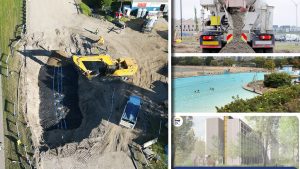Key construction health and safety stakeholders are playing it close to the vest as they ponder the outcome of the coroner’s inquest investigating Ontario’s notorious 2009 swing stage incident.
Others, meanwhile, have noted the decade-plus gap between the quadruple fatalities and the five-day inquest, and suggest health and safety in the construction sector today is light years ahead of where it stood in December 2009.
On Feb. 4 the coroner’s jury looking into the deaths of four construction workers on Christmas Eve 2009 delivered its verdicts, concluding the deaths were accidental and producing seven recommendations for reforms addressed to the Ministry of Labour, Training and Skills Development (MOL).
Counsel for the MOL had recommended the five-member jury pass on the opportunity to make recommendations, while a lawyer for the Ontario Building Trades had urged the jury to issue a set of 14 recommendations for reform covering a broad range of proposed training and other regulatory measures that would have involved action by the MOL and the Chief Prevention Officer.
“We want to get this right as there are a number of issues we need to address,” said Carmine Tiano, director of occupational services for the Building Trades. We are still reviewing the recommendations with our lawyers and are developing a response.”
Steven Grossman, executive assistant to Chief Prevention Officer Dr. Joel Moody, referred to the “sensitivities” of the inquest and indicated there would be no interviews given at present.
The MOL issued a statement indicating it is reviewing the inquest recommendations and how they may support the “significant” steps already taken to improve working at heights safety in Ontario since 2009.
My overwhelming issue with the recommendations is that they are coming 13 years after the incident. The industry is not in the same place,
— Giovanni Cautillo
Ontario General Contractors Association
The office of the Chief Prevention Officer was created following a December 2010 report by an Expert Advisory Panel on occupational health and safety chaired by Tony Dean. Numerous regulations were redrafted and new training regimes created as a result of the Dean report — a point raised by Ontario General Contractors Association president Giovanni Cautillo.
“My overwhelming issue with the recommendations is that they are coming 13 years after the incident,” said Cautillo. “The industry is not in the same place that it was over a decade ago and some of the recommendations have not only been in existence but accepted industry practice shortly after the incident.”
Cautillo said the entire industry worked together immediately after the swing stage incident with solutions that were universally supported.
“The construction industry is quick to change, but the data, information and possible recommendations need to be timely,” he said, “not recommendations 13 years post-accident.”
Metron Construction site supervisor Fayzullo Fazilov and workers Vladimir Korostin, Aleksey Blumberg and Alexander Bondorev fell 13 storeys to their deaths when their suspended work platform broke apart at an apartment restoration jobsite in Toronto. A statement of facts identified failure to use a fall arrest system and substandard fabrication of the swing stage as causes of the fatalities.
The coroner presiding over the inquest, Dr. John Carlisle, explained there was a 12-year gap between the incident and the inquest because other legal issues including criminal charges and charges under the Occupational Health and Safety Act had to be dealt with first, and also the pandemic further created delays.
Council of Ontario Construction Associations president Ian Cunningham noted most of the 46 recommendations of the Dean report have been implemented, including, of greatest significance according to Cunningham, the development of two successive Provincial Health and Safety Strategies that have all system partners aligned. Also, more than 500,000 workers have been trained in working at heights.
The introduction of the Certificate of Recognition safety program, the development of the WSIB’s Health and Safety Excellence program and the launch of the MOL’s Supporting Ontario’s Safe Employers program are other milestones Cunningham highlighted.
Future potential reforms he identified were better collection and sharing of data about incidents; the need for improved health and safety culture on jobsites; and the need for a speedier process to implement regulatory change.
“It can take years to implement proposals and in the meantime workers die and are injured,” said Cunningham.
The inquest jury’s recommendations to the MOL included suggestions to consider accelerating the frequency of refresher courses for using suspended equipment; to boost training of supervisors of workers working at heights and using a suspended work platform; to use emerging technologies to reduce worksite injuries; and to upgrade the tracking of the effectiveness of working at heights training.
The other recommendations included a request to consider additional penalties for supervisors who violate the regulations; to include a general mandatory requirement for training of health and safety representatives who work on construction projects; and to amend the notification requirements regarding the installation and testing of work platforms.
Follow the author on Twitter @DonWall_DCN.











Recent Comments
comments for this post are closed